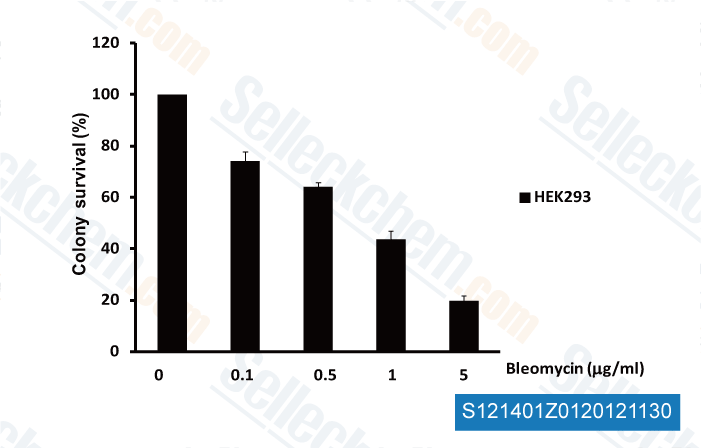|
Toll Free: (877) 796-6397 -- USA and Canada only -- |
Fax: +1-832-582-8590 Orders: +1-832-582-8158 |
Tech Support: +1-832-582-8158 Ext:3 Please provide your Order Number in the email. |
Technical Data
| Formula | C55H85N17O25S4 |
|||
| Molecular Weight | 1512.62 | CAS No. | 9041-93-4 | |
| Solubility (25°C)* | In vitro | Water | 100 mg/mL (66.11 mM) | |
| DMSO | 50 mg/mL (33.05 mM) | |||
| Ethanol | Insoluble | |||
|
* <1 mg/ml means slightly soluble or insoluble. * Please note that Selleck tests the solubility of all compounds in-house, and the actual solubility may differ slightly from published values. This is normal and is due to slight batch-to-batch variations. * Room temperature shipping (Stability testing shows this product can be shipped without any cooling measures.) |
||||
Preparing Stock Solutions
Biological Activity
| Description | Bleomycin sulfate is a glycopeptide antibiotic and a DNA synthesis inhibitor, as well as an anticancer agent for squamous cell carcinomas (SCC) with an IC50 of 4 nM in UT-SCC-19A cells. Bleomycin sulfate is a DNA synthesis inhibitor. |
|---|---|
| In vitro | UT-SCC-12A and UT-SCC-12B are both more resistant to Bleomycin sulfate with IC50 of 14.2 nM and 13 nM, respectively. [1] Alveolar macrophages incubated with 0.01 μg/mL to 1μg /mL Bleomycin sulfate for 18 hours secretes significantly more fibroblast growth factor than macrophages incubated without Bleomycin sulfate. Macrophages stimulated with Bleomycin sulfate continues to produce significant amounts of fibroblast growth factor even after Bleomycin sulfate is removed and replaced with fresh (Bleomycin sulfate-free) media. Fibroblast growth factor secretion by Bleomycin sulfate-stimulated alveolar macrophages is inhibited by cycloheximide, and the 5-lipoxygenase inhibitors NDGA (nordihydroguaiaretic acid) and BW755c, indicating not only a requirement for protein synthesis but also for metabolites of the 5-lipoxygenase pathway of arachidonic acid metabolism for full expression of activity. [2] Bleomycin sulfate (400 µg/mL) incubation for 24 hours decreases the viability of NTera-2 cells, and increases caspase-3, -8 and -9 activities, Bax and cytoplasmic cytochrome c levels and decreases Bcl-2 levels. [3] In terms of unstable aberrations, the clastogenic effect of Bleomycin sulfate on ADIPO-P2 cells persists for at least 10 days after exposure. Bleomycin sulfate-induced telomere instability in mammalian cells persists for several generations after exposure. Moreover, the appearance of telomere fusions in Bleomycin sulfate-exposed cells 10 days after treatment suggests that Bleomycin sulfate can induce delayed telomere instability. [4] |
| In vivo | Day 7 post-Bleomycin sulfate, CD45+ cells in BALf in NOX-/- is 1.7-fold > WT, 57% of which are Mf that decreases by 67% in WT and 83% in NOX-/- by Day 21. [5] |
Protocol (from reference)
| Cell Assay: |
|
|---|---|
| Animal Study: |
|
References
Customer Product Validation

-
Data from [Data independently produced by AACRElizabeth williamson from university of florida. , 2011]
Selleck's Bleomycin sulfate has been cited by 116 publications
| Profibrogenic macrophage-targeted delivery of mitochondrial protector via exosome formula for alleviating pulmonary fibrosis [ Bioact Mater, 2024, 32:488-501] | PubMed: 37965241 |
| Pro-ferroptotic signaling promotes arterial aging via vascular smooth muscle cell senescence [ Nat Commun, 2024, 15(1):1429] | PubMed: 38365899 |
| YTHDC1 delays cellular senescence and pulmonary fibrosis by activating ATR in an m6A-independent manner [ EMBO J, 2024, 43(1):61-86] | PubMed: 38177310 |
| Endothelial H2S-AMPK dysfunction upregulates the angiocrine factor PAI-1 and contributes to lung fibrosis [ Redox Biol, 2024, 70:103038] | PubMed: 38266576 |
| Tuberostemonine may enhance the function of the SLC7A11/glutamate antiporter to restrain the ferroptosis to alleviate pulmonary fibrosis [ J Ethnopharmacol, 2024, 318(Pt B):116983] | PubMed: 37532076 |
| Synthesis and Anti-Inflammatory Activity of Ferulic Acid-Sesquiterpene Lactone Hybrids [ Molecules, 2024, 29(5)936] | PubMed: 38474447 |
| D-type cyclins regulate DNA mismatch repair in the G1 and S phases of the cell cycle, maintaining genome stability [ bioRxiv, 2024, 2024.01.12.575420] | PubMed: 38260436 |
| OTUD5 limits replication fork instability by organizing chromatin remodelers [ Nucleic Acids Res, 2023, 51(19):10467-10483] | PubMed: 37713620 |
| SIRT1 ubiquitination is regulated by opposing activities of APC/C-Cdh1 and AROS during stress-induced premature senescence [ Exp Mol Med, 2023, 10.1038/s12276-023-01012-1] | PubMed: 37258580 |
| Inhibition of Th17 cells by donepezil ameliorates experimental lung fibrosis and pulmonary hypertension [ Theranostics, 2023, 13(6):1826-1842] | PubMed: 37064881 |
RETURN POLICY
Selleck Chemical’s Unconditional Return Policy ensures a smooth online shopping experience for our customers. If you are in any way unsatisfied with your purchase, you may return any item(s) within 7 days of receiving it. In the event of product quality issues, either protocol related or product related problems, you may return any item(s) within 365 days from the original purchase date. Please follow the instructions below when returning products.
SHIPPING AND STORAGE
Selleck products are transported at room temperature. If you receive the product at room temperature, please rest assured, the Selleck Quality Inspection Department has conducted experiments to verify that the normal temperature placement of one month will not affect the biological activity of powder products. After collecting, please store the product according to the requirements described in the datasheet. Most Selleck products are stable under the recommended conditions.
NOT FOR HUMAN, VETERINARY DIAGNOSTIC OR THERAPEUTIC USE.
